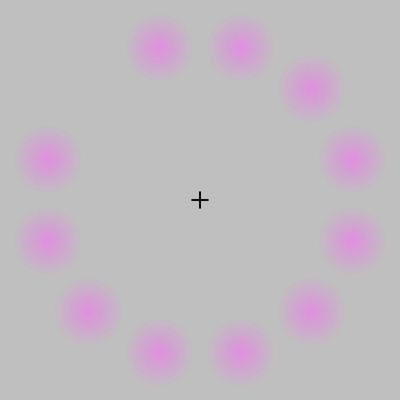Troxler's fading

Troxler's fading, or the Troxler Effect, is an optical illusion affecting visual perception. When one fixates on a particular point for even a short period of time, an unchanging stimulus away from the fixation point will fade away and disappear. Recent research suggests that at least some portion of the perceptual phenomenon associated with Troxler's fading occurred in the brain.
Phenomena identified
Troxler's fading was first identified by Ignaz Paul Vital Troxler in 1804.[1]
Process
Neural adaptation
Troxler's fading has been attributed to the adaptation of neurons vital for perceiving stimuli in the visual system.[2] It is part of the general principle in sensory systems that unvarying stimuli soon disappear from our awareness. For example, if a small piece of paper is dropped on the inside of one's forearm, it is felt for a short period of time. Soon, however, the sensation fades away. This is because the tactile neurons have adapted and start to ignore the unimportant stimulus. But if one jiggles one's arm up and down, giving varying stimulation, one will continue to feel the paper.
Visual parallels
A similar 'sensory fading,' or filling-in, can be seen of a fixated stimulus when its retinal image is made stationary on the retina (a stabilized retinal image). Stabilization can be done in at least three ways.
- First, one can mount a tiny projector on a contact lens. The projector shines an image into the eye. As the eye moves, the contact lens moves with it, so the image is always projected onto the same part of the retina;
- Second, one can monitor eye movements and move the stimulus to cancel the eye movements;
- Third, and this is the technique most people will know, one can induce an afterimage, usually by an intense, brief flash, such as when one is photographed using a photographic flash. This causes an image to be bleached onto the retina by the strong response of the rods and cones. In all these cases, the stimulus fades away after a short time and disappears.
The Troxler Effect is enhanced if the stimulus is small, is of low contrast (or "equiluminant"), or is blurred. The effect is enhanced the further the stimulus is away from the fixation point.
Explanation of effect
Troxler's fading can occur without any extraordinary stabilization of the retinal image in peripheral vision because the neurons in the visual system beyond the rods and cones have large receptive fields. This means that the small, involuntary eye movements made when fixating on something fail to move the stimulus onto a new cell's receptive field, in effect giving unvarying stimulation.[2] Further experimentation this century by Hsieh and Tse showed that at least some portion of the perceptual fading occurred in the brain, not in the eyes.[3]
See also
References
- ↑ Troxler, D. (I. P. V.) (1804). "Über das Verschwinden gegebener Gegenstände innerhalb unseres Gesichtskreises" [On the disappearance of given objects from our visual field]. In Himly, K.; Schmidt, J.A. Ophthalmologische Bibliothek (in German) 2 (2): 1–53. OCLC 491712012.
- ↑ 2.0 2.1 Martinez-Conde, Susana; MacKnik, Stephen L.; Hubel, David H. (2004). "The role of fixational eye movements in visual perception". Nature Reviews Neuroscience 5 (3): 229–40. doi:10.1038/nrn1348. PMID 14976522.
- ↑ Hsieh, P.-J.; Tse, P.U. (2006). "Illusory color mixing upon perceptual fading and filling-in does not result in 'forbidden colors'". Vision Research 46 (14): 2251–8. doi:10.1016/j.visres.2005.11.030. PMID 16469353.